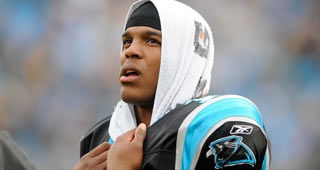There has never been a quarterback quite like Cam Newton before. A generation ago, 6’5 250 players who ran a 4.5 40 didn’t exist. If they did, they were made pass rushers or linemen. Quarterbacks were almost never the best athletes on their team.
Newton, after disciplinary problems at Florida sent him to junior college, was relatively unknown when he became Auburn’s starting quarterback before the 2010 season. He’s taken the football world by storm ever since. He was the first player to ever win the Heisman Trophy and a national championship in college, and then become the No. 1 overall pick and win the NFL Rookie of the Year Award.
He never lost a game at Auburn. His statistics, which he racked up against the most athletic defenses in the nation in the SEC, speak for themselves: a combined 4,326 total yards and 50 TD’s rushing and passing. Newton was bigger and faster than the players who were trying to tackle him, which made it pretty difficult for defenses to stop the Tigers' offense.
For a variety of reasons, Newton was not going to be returning for his senior year of college. As a result, there was a lot of doubt about his ability to succeed in the NFL, especially after his infamous TV interview with Jon Gruden when he struggled to diagram a play. Previous dual-threat QB’s like Michael Vick, Vince Young and Tim Tebow had been unable to translate a similar level of college dominance to the NFL.
But there are several important differences between Newton and the players who came before him. Vick, at 6’0 215, doesn’t have the size to stay healthy while running the ball over a 16-game season. Tebow and Young, meanwhile, aren’t capable enough as passers to be full-time starting QB’s in the NFL.
Newton is the first player with the necessary size, athleticism and passing ability to be a dual-threat QB in the NFL. Despite the concerns about him coming out of Auburn, he didn’t need much time to prove he could play at the next level. As a rookie, he completed 60% of his passes and threw for 4,051 yards while running for 706 yards and 14 TD’s.
He accounted for more TD’s (35) than a good number of NFL teams in 2012. One reason why his adjustment process wasn’t as difficult is that he is playing a different game than the league’s other 31 QB’s. NFL defenses have the same problem that SEC defenses had: if they commit enough men in the box to stop him from rushing the ball, he can beat them over the top with his arm.
For all of the defensive wizardry a coach like Bill Belichick can conjure up, football is still a game of arithmetic. If you have to commit an extra man in rush defense to account for the QB, that’s one less man you can drop into pass defense. Of course, this only works if a QB can withstand the beating that running the ball 10+ times a game requires.
That arithmetic is the reason why Tim Tebow was so successful with Denver. The Broncos were running a collegiate-style spread offense that his skills were most suited for, and his 6’3 250 frame allowed him to survive the hits he took. Newton creates all of the same problems while also having the ability to consistently beat defenses with his arm.
Now, headed into his second year in the NFL, the big question is whether he will improve his decision-making as a passer. His TD:INT ratio of 21:17 was acceptable for a rookie, but it’s still too high to be an elite passing QB. If Newton can cut down on his turnovers, the Panthers offense, which averaged 25 points a game in 2011, could become one of the league’s best in 2012.
At the college level, Newton, Tebow and Young dominated games as if they were Pop Warner contests. The team with the biggest, fastest and toughest player gave him the ball and let him run sweeps around the end. In their final seasons in college, their teams combined to go 40-1. That’s how dominant a great dual-threat QB can be.
If the QB has the ball in his hands most of the time, there’s no reason why he shouldn’t be the most athletic player on the team. Newton is the end result of the democratization of the position, as the type of instruction necessary for a young player to become a top-level QB is now available to players in high schools all over the country. The barriers, both cognitive and logistic, that prevented players from becoming QB’s have been lifted.
Could DeMarcus Ware, one of the only linebackers in the NFL who can stand toe-to-toe with Newton, have been a QB? There’s no way to know, but no one would have even asked the question a generation ago. Now, if a high school coach had a player with that type of size and athleticism, he’d at least have to consider playing him behind center.
Tyrone Swoopes, the nephew of WNBA star Cheryl, is a UT commit considered the No. 1 QB in the Class of 2013. He’s a 6’5 230 teenager with the athleticism to dunk over Julius Randle, a 6’9 240 jumping jack and Top 5 basketball player, in a summer-league game. It’s scary to think what Swoopes could be like after a few years in a collegiate weight room.
Every once in awhile, a transcendent player revolutionizes a position -- Lawrence Taylor at OLB, Tony Gonzalez at TE, Randy Moss at WR. Tom Brady to Rob Gronkowski is a great combination; Newton has the chance to be both at the same time. But while he may be the first of his kind, what’s more important is that he won’t be the last.

Jonathan Tjarks wrote on the NBA for RealGM from 2011-2016 before joining The Ringer.
Follow @JonathanTjarks on Twitter.


